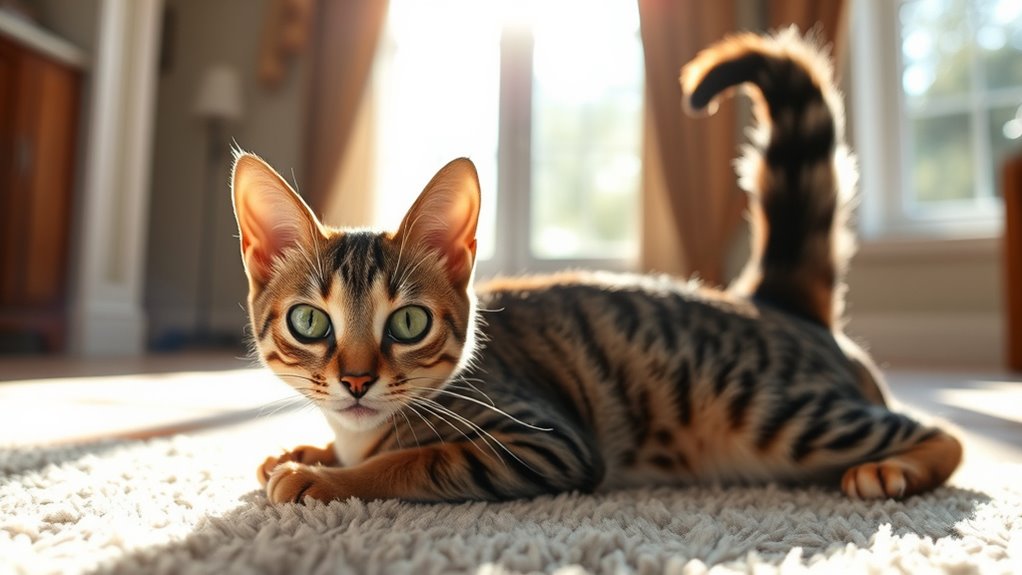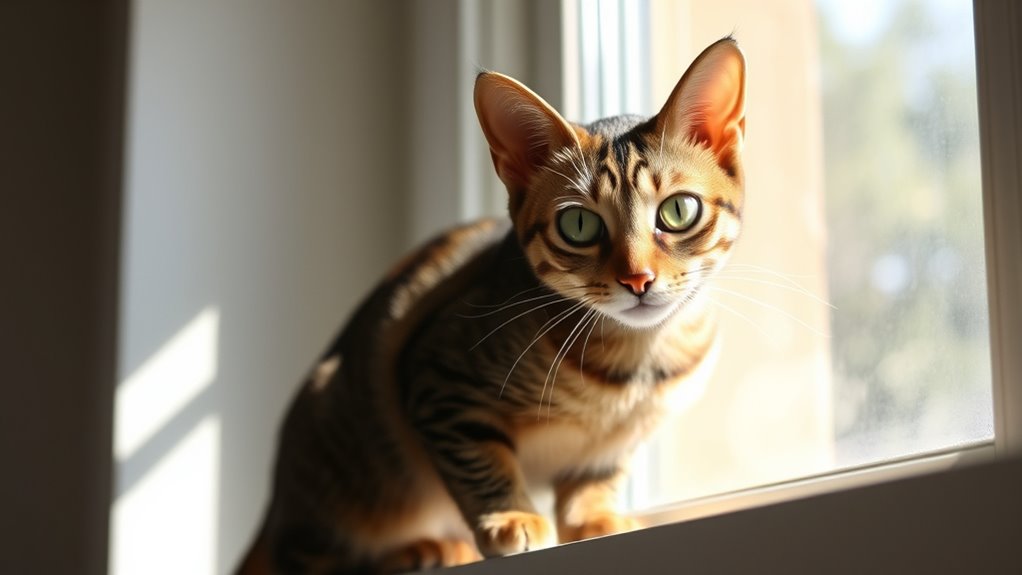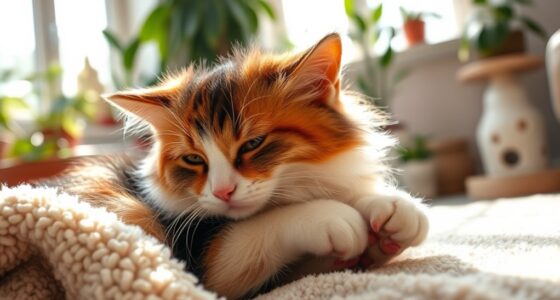Understanding cat body language is essential for connecting with your feline friend. Pay attention to their ears, eyes, and tail signals. Ears upright mean curiosity, while flattened ears indicate annoyance or fear. Slow blinking shows trust, but dilated pupils can signal aggression. A high tail suggests confidence, whereas a tucked tail implies insecurity. Recognizing these signs helps strengthen your bond and ensures a harmonious environment. Discovering more about these signals can enhance your communication skills even further.
Key Takeaways
- Ears facing upright indicate curiosity, while flattened ears signal annoyance or fear, requiring space.
- Slow blinking conveys trust and affection, enhancing the bond between cat and owner.
- A high-held tail shows confidence, while a low or tucked tail reflects insecurity or fear.
- Rapid tail swishing can indicate agitation or excitement, potentially leading to aggressive behavior.
- Understanding these body language signals fosters better communication and strengthens the relationship with your cat.

Understanding cat body language is essential for building a strong bond with your feline friend. Cats communicate a lot through their body language, and being able to interpret these signals can help you respond appropriately to their needs and moods. One of the first things you’ll notice is how your cat uses its ears, eyes, and tail. Each of these features plays a significant role in expressing emotions.
When your cat’s ears are upright and facing forward, it’s a good sign they’re curious or interested in something. This posture is often accompanied by playful gestures, like pouncing or batting at a toy. On the other hand, if their ears are flattened against their head, it may indicate they’re feeling threatened or annoyed. In this case, you’ll want to give them space and avoid any sudden movements that might escalate their discomfort.
Eyes are another essential aspect of feline communication. A slow blink can be a sign of trust and affection. If your cat looks at you and slowly closes its eyes, try returning the gesture. It’s like a cat version of a hug! However, if their pupils are dilated and they’re staring intently, it could mean they’re feeling aggressive or frightened. In this scenario, be cautious and observe their behavior closely; aggressive signals often accompany a tense body posture.
The tail is perhaps one of the most expressive parts of your cat. A tail held high indicates confidence and contentment, while a low or tucked tail usually means your cat is feeling insecure or scared. If their tail is swishing back and forth rapidly, it’s a sign of agitation or excitement, which could lead to aggressive behavior if not addressed. Pay attention to how your cat’s tail moves, as it can give you great insight into their emotional state.
Understanding these signals can enhance your relationship with your cat. By recognizing playful gestures, you can engage them in a fun game or interactive playtime, which strengthens your bond. Conversely, being aware of aggressive signals can help you avoid unnecessary confrontations, ensuring both you and your cat feel safe. Knowing how to read your cat’s body language allows you to respond thoughtfully, creating a harmonious environment for both of you. Remember, the more you understand their signals, the closer your connection will become. Additionally, participation in workshops and classes can further improve your ability to interpret feline behavior effectively.
Frequently Asked Questions
How Can I Tell if My Cat Is Happy?
You can tell your cat is happy when you notice playful gestures like pouncing or chasing toys. Their body language will be relaxed, and you might see them rolling over or kneading. Grooming cues, such as licking themselves or you, also indicate contentment. If your cat approaches you for affection, it’s a great sign they’re feeling good. Pay attention to these behaviors, and you’ll know your furry friend is happy!
What Do Different Purring Sounds Mean?
Have you ever wondered what your cat’s purring really means? Different purring sounds indicate various emotions and states. A low, rumbling purr often signals contentment, while a higher, rapid purr can express excitement or anxiety. Cats also use vocal expressions to communicate with you, so pay attention to the purring variations. Understanding these nuances helps you bond better with your furry friend and respond to their needs more effectively.
Why Does My Cat Knead My Lap?
Your cat kneads your lap because it’s a comforting behavior rooted in kittenhood, where they kneaded their mother for milk. You might notice your cat’s ears positioned forward and tail flicking gently while they do this, indicating contentment. This action helps them feel safe and secure, and it’s also a way for them to mark you with their scent. So, enjoy this affectionate moment with your furry friend!
Is Tail Chasing a Sign of Stress?
Tail chasing can be a troubling telltale sign of feline anxiety. If your cat’s darting after its own tail, it might be a mix of boredom or stress. Cats often exhibit this behavior when they’re feeling overwhelmed or under-stimulated. By providing plenty of playtime and mental challenges, you can help alleviate that anxiety. Just remember, it’s important to observe their overall behavior to ensure they’re happy and healthy.
How Can I Improve My Cat’s Body Language Understanding?
To improve your cat’s body language understanding, focus on observing feline facial cues and body posture analysis. Pay attention to their ears, eyes, and tail positions, as these signals reveal their mood. Spend time interacting with your cat, allowing them to express themselves. Create a calm environment where they feel safe, encouraging natural behaviors. Consistently engage with them, and you’ll soon recognize their unique communication style, enhancing your bond.
Conclusion
By tuning into your cat’s body language, you reveal a secret world of communication. Picture their ears flicking like radar, eyes narrowing into slits of intrigue, and tails swaying gracefully like a dancer. Each movement tells a story, revealing their moods and desires. When you pay attention, you’ll see the subtle shifts—a flick of the tail or a soft purr—and connect on a deeper level. Embrace these cues, and your bond with your feline friend will grow stronger.










